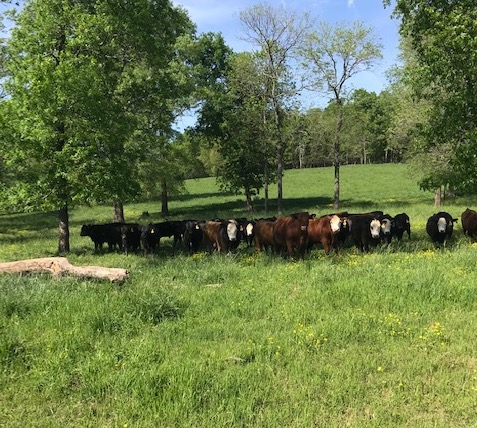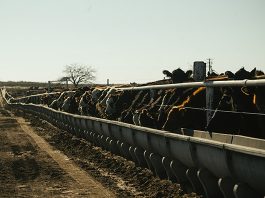 About three years ago, I decided I would try my hand at raising some purchased stocker calves. I had kept brood cows on several different farms around my part of central North Carolina for over 10 years, and I was ready to try something new. I had run the numbers on stockers several times over the years, and on paper it always seemed like they would provide a pretty good return. However, there was always some reason why it wasn’t a good time to actually go for it, mainly that my pastures were full of cows and I had no room for any additional cattle.
About three years ago, I decided I would try my hand at raising some purchased stocker calves. I had kept brood cows on several different farms around my part of central North Carolina for over 10 years, and I was ready to try something new. I had run the numbers on stockers several times over the years, and on paper it always seemed like they would provide a pretty good return. However, there was always some reason why it wasn’t a good time to actually go for it, mainly that my pastures were full of cows and I had no room for any additional cattle.
In the spring of 2017 I quit making my own hay and I sold all of my hay equipment. I had one farm that I was just using to make hay on, mostly winter annuals in the spring and volunteer warm season grasses in the summer. I put some replacement heifers on this farm over the summer after selling my hay equipment. The following fall, I sold the heifers, planted the place in winter annuals, and used the money from selling the hay equipment to buy some steers to carry over the winter.
Fast forward a few years to today. I have now sold all of my brood cows, most of the equipment that I had left, and am running all stocker cattle. The calves I was selling off my own cows were barely bringing in enough to pay the cost of keeping the cows up all year. I’ve found that, in a lower priced cattle market, stockers provide a lot more opportunities to make a profit than cows do, at least in my area.

One of the reasons I was struggling to make a profit with cows was winter feed costs. July through early October is typically pretty hot and dry here. It’s hard to stockpile much winter forage if you have a cow herd eating the grass down this time of year. That meant, I usually fed hay for 60 days from mid August to mid October to try to keep the cows off the pasture so it could grow. My stockpile would then typically last from mid October to mid January, when I would start feeding hay again until the end of March. By mid May, my pastures had way more grass in them than the cows could eat, so I would mow and bale it to feed the next year. I was not happy with this system, and figured there had to be better way.
After my first set of stocker calves made a little money, I wondered if I could run stockers on perennial pastures as successfully as on the annual pastures I was planting. My pastures are Kentucky 31 fescue-based, but they have a lot of white clover, orchardgrass, some bluegrass, and several species of volunteer warm season grasses in them as well.

A lot of articles I read said that stocker calves wouldn’t work on fescue. I kept digging, and found Dr. Gordon Hazard’s book, “Thoughts and Advice From an Old Cattleman.” He grazed steers on fescue-based pastures profitably for many years. Dr. Hazard’s approach was to buy calves in the fall, winter them on fescue, and sell them the next summer. I gave this method a try, and liked it even better than using winter annuals. My calves didn’t gain as much on the fescue-based pasture, but they ended up making more money with less work involved because I didn’t have to plant everything they ate and feed them until it was ready to graze. I just bought the calves in late October and strip grazed them on stockpiled fescue until the following spring.
I sold the rest of my cows, and let all my pastures grow through the late summer and fall to stockpile winter forage. This prevented overgrazing during a normally stressful period on the grass, and allowed enough cover to capture any rainfall that we did have. When the temperatures cooled off and rain started coming more frequently, the grass took off growing.
Lots of Options for Profit With Stockers
Stocker cattle give you a lot more opportunity to turn your money over than cows do. When you buy a cow, she’s on your books for one year up to fifteen years. She may or may not give you a calf each of these years, and that calf may or may not pay for her upkeep that year. When you buy stockers, you keep him (or her) for two to nine months. You sell the calf, get the money you paid for it back, buy another calf, and have some money left over.
With stockers, you have control over what you buy each year. You can buy small cattle and grow them into big cattle. You can buy singles and group them into load lots. You can buy bulls and castrate them and sell steers. You can buy heifers and keep them 9 months and sell them as guaranteed open, or breed them and sell replacements.
There are a lot of options and ways to add value to stockers, and do it in a way that maximizes use of your forage resources while minimizing purchased feed. It takes a lot less time to recoup your up front investment for a group of stockers than it does a herd of brood cows, making it an excellent option for someone who wants to get started in cattle but doesn’t have the money to buy a herd of cows and pay the expenses until their calves are sold. In addition to all of this, you can keep about two calves on the same amount of land required by one cow.

Some Risks
Stocker calves are not without challenge, however. Possibly the hardest part about them is that they are likely to get sick during the first few weeks you have them, especially if they weren’t weaned or vaccinated when you bought them and if they came from a sale barn. With good animal husbandry, good nutrition, a good vaccination program, and judicious use of antibiotics when necessary, you can usually manage to get them healthy and gaining weight pretty quickly. If you are interested in a program that doesn’t use antibiotics, buying weaned, vaccinated cattle straight off the farm is probably a good idea. Other risks, such as the market can be managed. I believe the benefits of running a stocker operation far outweigh the challenges.
Other Benefits
Stockers have been a great way to add value to my grass, improve my pastures, and make more money from my land resources. I can spend more time away from the farm, because I’m not making hay all summer and feeding it all winter. Additionally, there are times of the year when I sell out and don’t have any cattle to take care of, allowing me to get away from the farm without worrying about who will take care of the cows. This has turned out to be a pretty good enterprise, one that I enjoy and hope to continue growing.
Read the next in the series: Planning for a Stocker Operation- Homework to Do If You’re Considering This Option.





I am new to cattle. I found Dr Gordon Hazard while researching on how I wanted to start my cattle operation. I’ve consumed everything of him that I can and have modeled my operation after his or as closely as I can at this time. So great to see others found his work as valuable as I think it is. Thanks for the article and nice read. Would love to pick someone’s brain who has the same approach as myself but with a lot more experience. Maybe help me through the growing pains.
Thanks for this, Blake.
One thing I would mention to other readers is to carefully read the sections on options for profit and risk. Stocker operations require significant experience and skill. Selecting and buying calves, managing a health and nutrition program, running the grazing plan, understanding marketing… these are high-skill ventures, and not for the faint of heart. In your case, Blake, it looks as if you have perhaps ten years of experience and a ton of education.
Keep up the good work!
I think you made the right decision, but I think you could do even better by focusing on native warm-season grasses from May through early to mid-August, even the end of August. I outstanding gains (adg 2.0) during that period when steers would barely gain or lose on csg, a.k.a. tall fescue. I sell everything in September and October. I have no desire to cut ice, feed hay, or repair damaged pastures. I patch-burn graze my native grass so don’t have any interior fences or worry about rotating. The animals do that themselves. I begin in April on csg but move to a big bluestem, little bluestem, indiangrass, and eastern gamagrass mixture the first week of May. I also have bobwhite quail back. My animal performance parallels Dr. Pat Keyser’s (UT) research.
Care to share some of your “average” profit per head and or expense side? Thanks GW
How about we do that in an upcoming article?
Yes, lets do that, I too am curious as to actual numbers.
Comments are closed.